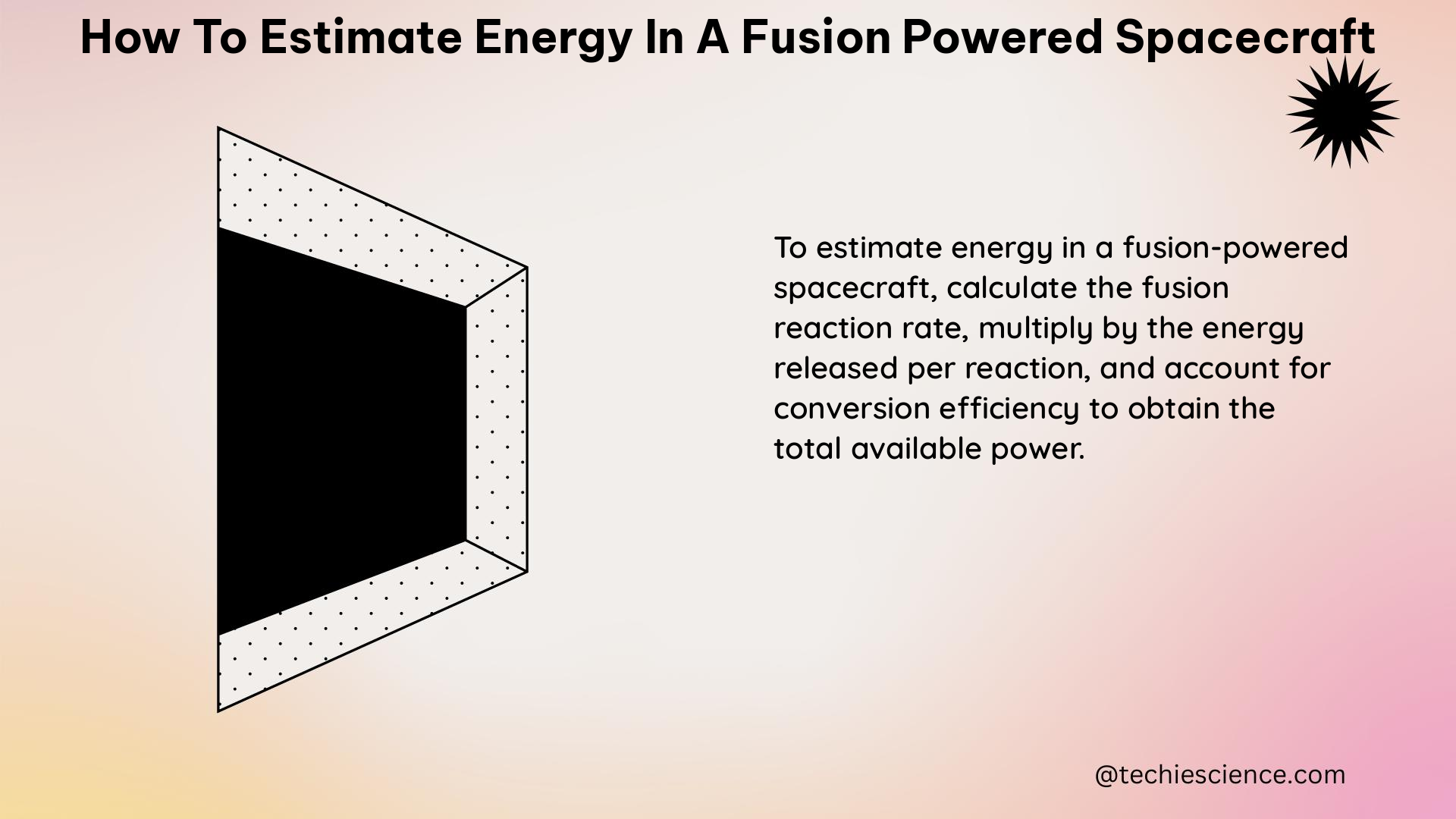Estimating the energy required for a fusion-powered spacecraft involves considering the type of fusion reaction, the efficiency of the energy conversion process, and the specific mission requirements. This comprehensive guide will provide you with the necessary formulas, physics principles, and practical examples to accurately estimate the energy needs of a fusion-powered spacecraft.
Understanding Fusion Reactions
The most common fusion reaction for spacecraft propulsion is the deuterium-tritium (D-T) reaction, which produces a helium nucleus, a neutron, and a large amount of energy. The energy released in this reaction can be calculated using the following formula:
Q = (m1 + m2 - m3 - m4)c^2
Where:
– Q is the energy released (in Joules)
– m1 and m2 are the masses of the reactants (deuterium and tritium, respectively)
– m3 and m4 are the masses of the products (helium nucleus and neutron, respectively)
– c is the speed of light (3 x 10^8 m/s)
For the D-T reaction, the energy released can be calculated as:
Q = (2.014102 + 3.016049 - 4.002603 - 1.008665) × (3 × 10^8)^2
Q = 17.59 MeV
This energy release is a crucial factor in estimating the overall energy requirements of a fusion-powered spacecraft.
Energy Conversion Efficiency

In a fusion-powered spacecraft, the energy released in the fusion reaction must be converted into electrical energy to power the spacecraft’s systems. This energy conversion process typically involves a heat exchanger and a turbine, similar to the way fossil fuel power plants generate electricity.
The efficiency of this energy conversion process can be calculated using the following formula:
η = Pout / Pin
Where:
– η is the efficiency (dimensionless)
– Pout is the output power (in Watts)
– Pin is the input power (in Watts)
Assuming an energy conversion efficiency of 50%, the available electrical power from the fusion reaction can be calculated as:
Pout = Q × η
Pout = 17.59 × 10^6 × 0.5
Pout = 8.795 × 10^6 Watts
This electrical power can then be used to power the spacecraft’s systems and propulsion.
Mission Requirements
The amount of energy required for a mission will depend on several factors, including the distance to be traveled, the mass of the spacecraft, and the desired velocity. The energy required for a mission can be calculated using the following formula:
E = 1/2 × m × v^2
Where:
– E is the energy required (in Joules)
– m is the mass of the spacecraft (in kg)
– v is the desired velocity (in m/s)
For example, let’s assume we have a fusion-powered spacecraft with a mass of 10,000 kg, and we want to travel to Mars, which is about 54.6 million kilometers away. The desired velocity for this mission would be approximately 5 km/s.
Using the formulas and values provided, we can calculate the energy required for this mission:
E = (m1 + m2 - m3 - m4)c^2 × η × 1/2 × m × v^2
E = 17.59 × 10^6 × 0.5 × 1/2 × 10,000 × (5,000)^2
E = 2.15 × 10^12 Joules
Therefore, a fusion-powered spacecraft with a mass of 10,000 kg traveling to Mars at a velocity of 5 km/s would require approximately 2.15 × 10^12 Joules of energy.
Practical Considerations
When estimating the energy requirements for a fusion-powered spacecraft, there are several additional factors to consider:
- Fuel Consumption: The amount of fuel (deuterium and tritium) required for the mission, and the energy needed to store and transport the fuel.
- Spacecraft Design: The energy requirements for various subsystems, such as life support, communication, and navigation.
- Mission Duration: The energy needed to sustain the spacecraft’s operations for the entire duration of the mission.
- Redundancy and Safety Factors: Additional energy reserves to account for unexpected events or system failures.
- Thermal Management: The energy required for cooling and heat dissipation systems.
- Propulsion System Efficiency: The efficiency of the fusion-based propulsion system, which can impact the overall energy requirements.
By considering these practical factors, you can refine your energy estimates and ensure that the fusion-powered spacecraft has sufficient energy to complete its mission successfully.
Conclusion
Estimating the energy required for a fusion-powered spacecraft involves a comprehensive understanding of fusion reactions, energy conversion processes, and mission-specific requirements. By using the formulas, principles, and examples provided in this guide, you can accurately calculate the energy needs of a fusion-powered spacecraft for a given mission. Remember to consider the practical factors that can impact the energy requirements to ensure a successful and reliable spacecraft design.
Reference:
- Fusion Propulsion Z-Pinch Engine Concept
- Fusion Energy for Space Propulsion
- Analysis of the possible contribution of different nuclear fusion technologies to the global energy transition
- Query: Bring measurable,quantifiable data on how to estimate energy in a fusion powered spacecraft

The lambdageeks.com Core SME Team is a group of experienced subject matter experts from diverse scientific and technical fields including Physics, Chemistry, Technology,Electronics & Electrical Engineering, Automotive, Mechanical Engineering. Our team collaborates to create high-quality, well-researched articles on a wide range of science and technology topics for the lambdageeks.com website.
All Our Senior SME are having more than 7 Years of experience in the respective fields . They are either Working Industry Professionals or assocaited With different Universities. Refer Our Authors Page to get to know About our Core SMEs.